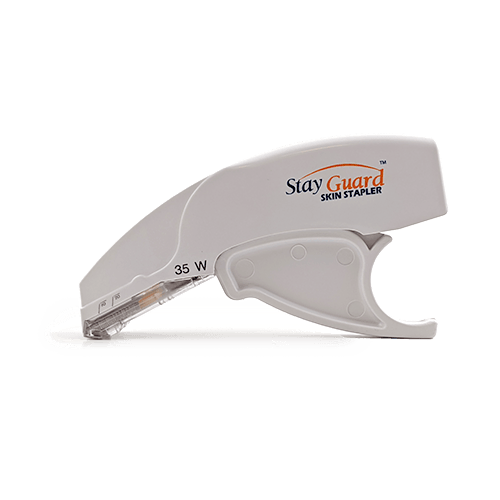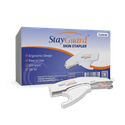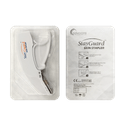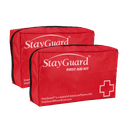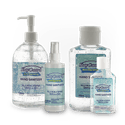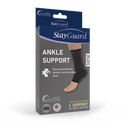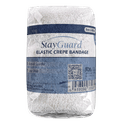- Home›
- Medical Devices›
- Skin & Wound Care›
- Wound Closure Instruments›
- Skin Stapler
Skin Stapler
Wire Diameter
Staples Load
Packaging
What is a Skin Stapler?
A Skin Stapler is a medical tool used to close wounds by applying metal staples to hold the edges of the skin together. This stapling device provides a quick method of wound closure, reducing the time required for suturing and promoting faster healing. Each load contains 35 pieces of 0.6mm staples.
The surgical stapler is a sterile and disposable instrument, ensuring hygienic and safe wound closure procedures in various medical settings.
AdvaCare Pharma is a leader in the manufacturing of Skin Staplers. Our products are made to the highest standards of quality and safety. Our production facilities are ISO and CE certified, and we adhere to all healthcare and regulatory guidelines. Regular inspections are conducted to ensure the consistent availability of dependable medical supplies.
Product Specifications
Features
Skin Stapler is a sterile medical device designed for wound closure. It is made of high-quality, medical-grade hardened plastic, ensuring durability and compatibility with medical applications. The staple size after closure measures 7.2mm x 4.9mm, with a diameter of 0.6mm. With its ergonomic design, the stapler is user-friendly and easy to use, providing efficient and reliable wound closure in medical settings.
Why are we a top Skin Stapler manufacturer?
For more than 20 years, AdvaCare Pharma has been a trusted exporter and manufacturer of Skin Staplers and other high-quality medical supplies for wound closure. Our extensive network of partnerships with distributors, hospitals, clinics, NGOs, and pharmacies in 65 markets worldwide speaks to our reputation and commitment.
At AdvaCare Pharma, our primary goal is to manufacture skin staplers, and other wound closure devices for surgical procedures, that are quality-assured and cost-effective. Through our StayGuard™ line of skin and wound care products, we aim to meet the ever-changing demands of global healthcare professionals and support the success of our partners.
Uses
How do you check for the correct alignment of a Skin Stapler during wound closure?
Confirming the correct alignment of a skin stapler is paramount for achieving successful wound closure. Before deploying the staples, carefully position the stapler's jaws parallel to the edges of the wound.
This alignment guarantees that the staples penetrate the skin evenly on both sides of the wound, holding it securely in place without causing tissue damage or misalignment.
Healthcare professionals should maintain a steady hand position and avoid angling the stapler, as any deviation from the correct alignment can result in uneven closure or potential complications during the healing process.
What are the advantages of using a Skin Stapler over traditional sutures for wound closure?
Skin staplers offer several distinct advantages over traditional sutures for wound closure:
- They deliver a faster and more efficient method of closure, reducing the time required for the procedure. This can be particularly beneficial in emergency situations or high-volume surgical settings where time is of the essence.
- Skin staplers are generally easier to use, especially for healthcare professionals who may have limited experience with suturing techniques.
- The straightforward mechanism of skin staplers allows for quick and intuitive application, resulting in consistent and reliable closure with minimal risk of errors.
- Skin staples typically produce less tissue trauma and inflammation compared to sutures, leading to better patient comfort and faster healing times.
- Their design also reduces the risk of needlestick injuries for healthcare staff, elevating overall safety in the operating room or clinical setting.
Can Skin Staplers be used for closing wounds in pediatric patients?
Yes, skin staplers can be used for closing wounds in pediatric patients, but certain considerations should be taken into account to obtain ideal outcomes and patient comfort.
Pediatric skin tends to be more delicate and sensitive compared to adult skin, requiring a gentle approach during wound closure. Healthcare workers should carefully select an appropriate staple size and spacing to achieve a secure closure without causing unnecessary trauma or discomfort to the child.
Close attention must be paid to the placement of staples to avoid any interference with growth or development in pediatric patients. Regular monitoring for signs of irritation, allergic reactions, or discomfort following stapling is all-important, and practitioners should be prepared to adjust their management accordingly to guarantee the best possible outcome for the young patient.
How does the design of a Skin Stapler contribute to its ease of use in clinical settings?
The design of a skin stapler guarantees its ease of use in clinical settings. These staplers are typically ergonomically designed with a comfortable grip and intuitive controls, allowing healthcare professionals to operate them with precision and efficiency.
The lightweight and compact nature of skin staplers make them easy to handle during procedures, reducing fatigue and supporting steady hand control. Our skin staplers feature clear staple count indicators and audible feedback mechanisms to alert users when staples are being deployed, strengthening procedural accuracy and safety.
The simplicity of the design also encourages quick reloading of staples, minimizing downtime between procedures and optimizing workflow in busy clinical environments. The user-friendly design of skin staplers adds to their usability and efficacy in various medical settings.
What steps should be taken for proper maintenance and storage of Skin Staplers?
Proper maintenance and storage of skin staplers are needed to secure their functionality and longevity. After use, the skin stapler should be disposed of as biomedical waste and contact should be avoided to prevent cross-contamination and infection transmission between healthcare professionals and patients.
When not in use, skin staplers should remain sealed and stored in a clean and dry environment, preferably in a designated storage case or tray to protect them from dust, moisture, and physical damage. Good storage conditions prolong the lifespan of skin staplers and guarantee their readiness for use in clinical settings.
What are some common complications associated with the use of Skin Staplers, and how can they be mitigated?
While skin staplers are generally safe for wound closure, certain complications can arise if they are not used correctly or if patient factors are not adequately considered.
One common complication is staple misfiring, where staples may be improperly deployed or fail to penetrate the skin, resulting in incomplete closure or wound dehiscence. This risk can be minimized with suitable alignment of the stapler with the wound edges and maintaining consistent pressure during staple deployment.
Another potential complication is staple line infection, particularly if staples are applied to contaminated or dirty wounds. To mitigate this risk, thorough wound debridement and irrigation should be performed before stapling, and appropriate antimicrobial dressings may be applied post-procedure.
Allergic reactions to staples or adhesive materials used in skin closure can occur in some patients, necessitating careful selection of materials and close monitoring for adverse reactions during and after the procedure.
Overall, adherence to best practices in wound management and meticulous technique can help minimize the risk of complications associated with skin stapler use.
In what clinical scenarios are Skin Staplers preferred over other methods of wound closure, such as sutures or tissue adhesives?
Skin staplers are preferred over other methods of wound closure in various clinical scenarios due to their unique advantages and versatility. In cases of traumatic lacerations or surgical incisions with straight, easily approximated wound edges, skin staplers present a rapid and efficient means of closure, reducing procedure time and maximising patient outcomes.
Skin staplers are particularly useful in emergency settings or situations where rapid wound closure is demanded to control bleeding and prevent infection. Skin staplers are well-suited for closing wounds in anatomically challenging areas or regions with high tension, where traditional suturing techniques may be difficult or time-consuming.
FAQs
How does a Skin Stapler work?
A skin stapler works by applying metal staples to the edges of a wound, holding the skin together for proper healing. The staples are inserted using a specialized stapling device, providing a quick and efficient method of wound closure.
What are the primary features of your Skin Staplers?
Our skin staplers are designed with precision engineering and technology to provide fast, efficient, and reliable wound closure. They offer ergonomic handles for comfortable grip and control, as well as sterile, single-use cartridges for convenient and hygienic application. The titanium staples ensure secure closure and minimal tissue trauma, promoting optimal wound healing.
Can a Skin Stapler be reused?
No, skin staplers are typically designed for single-use and are intended to be sterile. Reusing a skin stapler can pose risks of infection and cross-contamination, so it is important to use a new, sterile stapler for each patient or procedure.
What are the advantages of using disposable Skin Staplers over reusable ones?
Disposable skin staplers help minimize the risk of cross-contamination and healthcare-associated infections by providing a sterile, single-use solution for wound closure. This reduces the need for sterilization between procedures, enhancing patient safety. Single-use skin staplers also streamline the surgical workflow by simplifying instrument preparation and reducing turnaround times between procedures.
What are Skin Staplers made of?
Skin staplers are made of a proprietary polyurethane material, a medical-grade sterile plastic, which is an environmentally-friendly material known for its strength and biocompatibility. This material ensures that the staples are sturdy and compatible with the human body.
How long do skin staples stay in place?
The duration that skin staples remain in place depends on several factors, such as the location and type of wound, as well as the healing progress. In general, skin staples are typically removed within 7 to 14 days, but the specific timeframe should be determined by a healthcare professional based on individual circumstances.
References
Study of Comparison Between Skin Sutures and Skin Staplers
This study compared skin sutures and skin staplers in 400 patients over 20 months to evaluate effectiveness and complications. Results showed that staplers took less time for closure (1.84 min per 10 cm) compared to sutures (6.61 min per 10 cm) with lower complication rates (12% for staplers vs. 30% for sutures). The outcome of staplers was cosmetically superior with fewer complications.
Prospective Study Using Skin Staplers in Head and Neck Surgery
This prospective trial compared stapled skin closure versus conventional nylon sutures in head and neck surgery. Results showed that skin staples reduced closure time by 80%, provided similar cosmetic results with no increase in complications compared to sutures. The study emphasized the efficiency and cosmetic benefits of using skin staples in surgical procedures.

You might be interested in...
Why AdvaCare Pharma?
As an industry leader, we are aware of our responsibility to provide affordable and sustainable solutions to improve healthcare worldwide.


